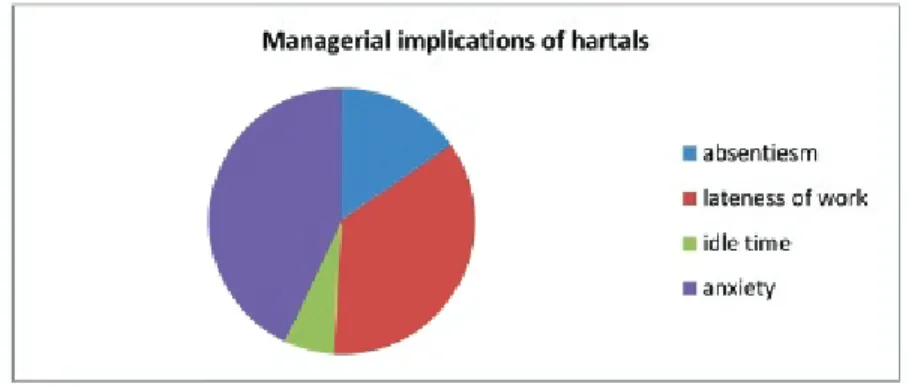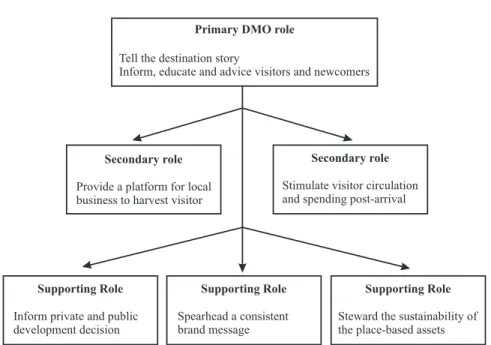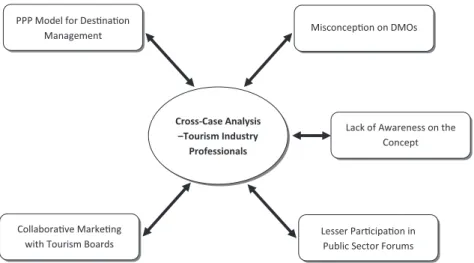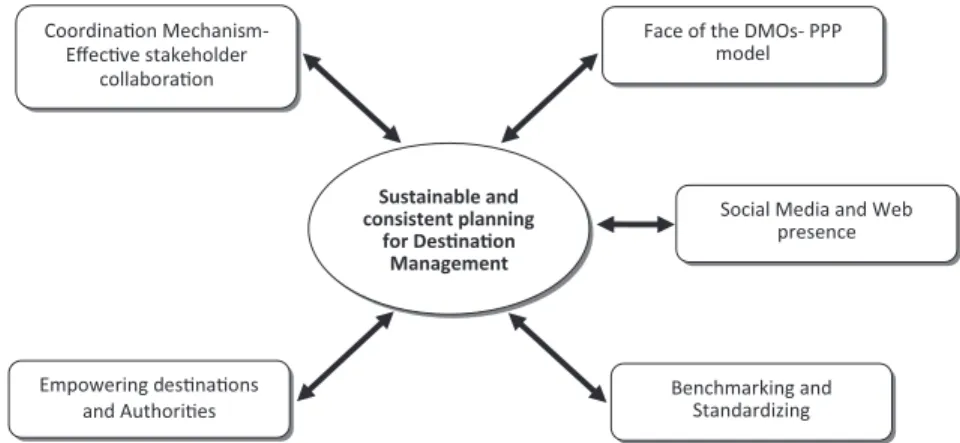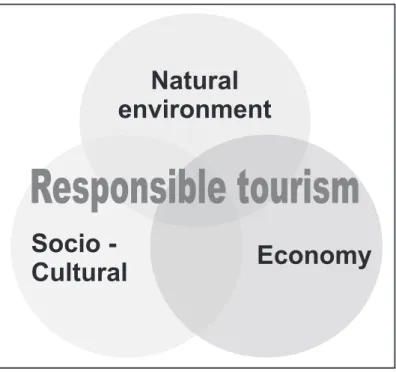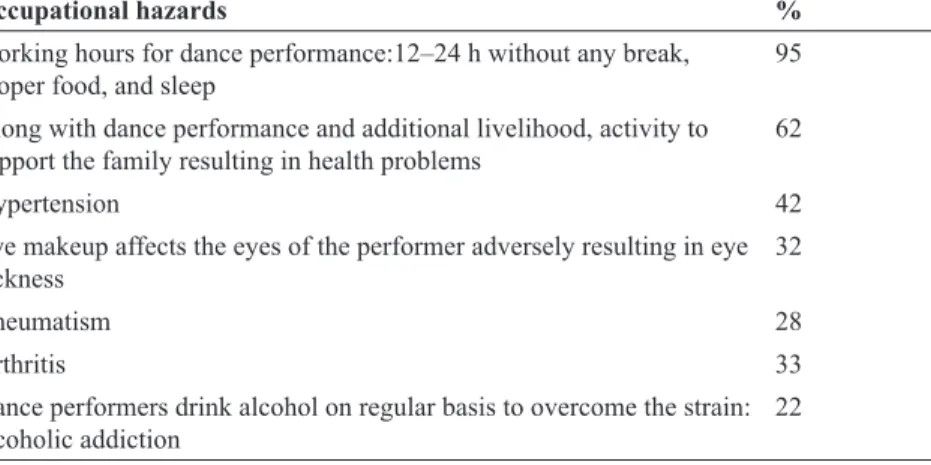The second section of the book is a comprehensive view of the operational and management perspectives in the tourism sector. The third part of the book is a comprehensive proposal on the new areas in the tourism sector.
DESTINATION MANAGEMENT AND COMPETITIVENESS: INTERVENTION
CONTENTS
INTRODUCTION
- TOURISM IN INDIA
- TOURISM POLICIES OF INDIA
- NEED FOR DESTINATION MANAGEMENT
- FIVE A’S OF TOURISM AND DESTINATION MANAGEMENT ORGANIZATIONS
Due to the high growth and development of the tourism industry, controlling the impacts on destinations is a necessity. The infrastructure of a destination is a mix of all the facilities integrated into the destination provided and maintained for the benefit of visitors.
THE MARKETING PERSPECTIVE OF DESTINATION MANAGEMENT ORGANIZATIONS
- THE MANAGEMENT PERSPECTIVE OF DESTINATION MANAGEMENT ORGANIZATIONS
- DESTINATION MANAGEMENT ORGANIZATIONS FOR GLOBAL COMPETENCY
- DESTINATION MANAGEMENT: A MAJOR PARAMETER IN TOURISM POLICY
The most important factors to observe are the competitiveness and sustainability of the destination (p. 145). Ritchie and Crouch (2003) indicate the areas that a tourism policy should broadly address to achieve overall destination management and ensure the long-term success of the destination.
OPERATIONAL PERSPECTIVES OF DESTINATION MANAGEMENT ORGANIZATIONS
- TYPES OF DESTINATION MANAGEMENT ORGANIZATIONS
- ROLE OF DESTINATION MANAGEMENT ORGANIZATION DMO will be a dominant and most influential body to manage a destina-
To provide a healthy experience to the tourist, all destination actors must provide value to the tourist. Interest will also be in providing a level of support for the visitor at the destination (information leaflets and visitor centres) (p. 73) (Fig. 1.1).
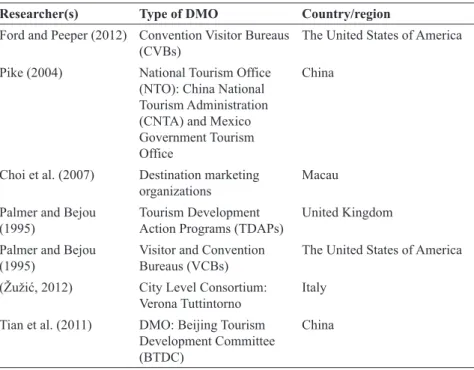
CORE FUNCTIONS OF DESTINATION MANAGEMENT ORGANIZATIONS
- METHODOLOGICAL PATH ASSESSMENT
- IMPLICATIONS FOR DESTINATION MANAGEMENT ORGANIZATIONS
Future of DMOs and how they can evolve in response to the changing needs of the tourism system and external change drivers (Pollock, 2008). The public sector's views on destination management emphasized the establishment of a sustainable outlook in tourism for the long-term success of the destination.
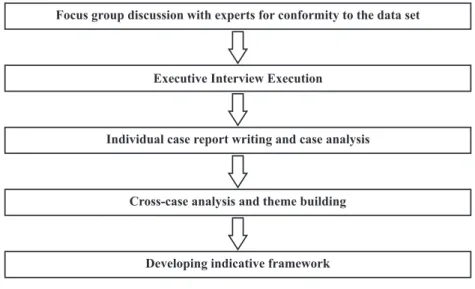
CONCLUSION
Destination Marketing Policy: Assessing Choice Orientations of Stakeholder Interaction Towards DMO Design Using the Thomas-Kilmann Conflict Mode Instrument. Understanding Strategic Alignment for Destination Marketing and the Athens 2004 Olympic Games: Implications for Acquired Tacit Knowledge.
POLICING TOURISM: CHALLENGES AND OPPORTUNITIES OF TOURIST
CHAITANYA PRADEEP
- INTRODUCTION
- CONCEPTUAL UNDERSTANDING
- TOURISM SECURITY
- TOURISM SECURITY AND THE CRIMINAL BEHAVIOR To complicate matters further, tourism security deals with much more
- THEORETICAL UNDERSTANDING: CRIME AND TOURISM There are several perspectives relating to tourism and crime. Among
- SOCIAL DISORGANIZATION THEORY
- HOT-SPOT THEORY
- ROUTINE ACTIVITY THEORY
- APPROACHES TOWARD CRIME AND TOURISM
- CONTEXTUALIZING “CRIME AND TOURISM”
- CRIME VICTIMIZATION AND TOURISM
- CRIME AGAINST FOREIGNERS IN INDIA
- VISITOR PERCEPTIONS IN RELATION TO CRIME AND SAFETY IN INDIA
- RELATIONSHIP BETWEEN TOURISM AND CRIME: AN ANALYSIS
- CRIME PREVENTION STRATEGIES IN RELATION TO TOURISM
Terms include the “accidental tourist” (being in the wrong place at the wrong time); tourism industry. The discussion of the literature on tourists and offenders shows a link between tourism and property-related offences.
Natural environment
This concept is in line with the principles of social and economic justice and exercises full respect for the environment and its cultures� It recognizes the central role of the local host community and its right to act as a key player in the development of a sustainable and responsible tourism. Responsible tourism promotes positive interaction between the tourism industry, local communities and travelers (Italian Association for Responsible Tourism (aitr.org, 2005)).
Socio -
Responsible tourism
EXPERIENCES OF VISIBLE POLICING
On the one hand, the police must be trained on how to deal with crimes against tourists and on the other hand, crimes committed by tourists. Police services, infrastructure and judicial processes must be developed to deal with transient populations in line with policing in industrialized areas.
TOPPS: A MODEL OF POLICING TOURIST CRIME
The prevailing view was that "security added nothing to the bottom line." TOPP's philosophy reverses this assumption and sees security as an important post-9/11 marketing tool. The philosophy behind TOPPs must thus be aligned with the social, economic and ecological requirements of the respective tourist sites.
CONCLUSION
Paper presented at the Third Annual Meeting of the Caribbean Studies Association, Port-au-Prince, Haiti, 1981. Tourism and Crime in the Caribbean: Some Lessons from the United States Virgin Islands� Paper presented at the Third Annual Meeting of the Caribbean Studies Association, Port-au- Prince, Haiti, 1983.
VISITOR MANAGEMENT AND
COMMUNITY PARTICIPATION IN AN ECOTOURISM DESTINATION: THE
- INTRODUCTION
- OBJECTIVES OF THE STUDY
- SCOPE OF THE STUDY
- REVIEW OF LITERATURE
- VISITOR SATISFACTION
- COMMUNITY PARTICIPATION
- RESPONSIBLE TOURISM
- COMMUNITY EMPOWERMENT
- RESEARCH DESIGN .1 DATA COLLECTION
- DATA ANALYSIS
- KANHA TIGER RESERVE (KTR)—A KALEIDOSCOPIC VIEW One of the biggest and enamoring national parks and tiger reserves in
- THE FACETS OF ECOTOURISM IN KTR
- PERSPECTIVES OF VISITOR MANAGEMENT—
- PERSPECTIVES OF COMMUNITY MANAGEMENT—
- CONCLUSION
The scope of this work covers ecotourism projects in one of the brilliant National Parks of the country – KTR located in a prime tourist destination – Madhya Pradesh, focusing on the visitor management agenda designed by the park managers to mitigate the negative impacts of tourism as well as the dynamics of inclusion communities to protect resources. The forest territories of Kanhe are inhabited by two indigenous tribes - Gondi and Baigas.
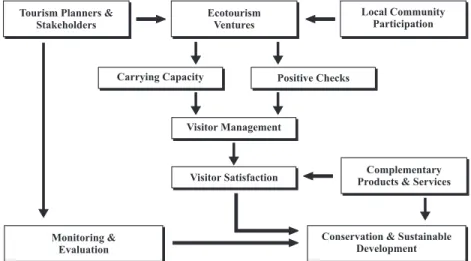
EMPOWERMENT OF MARGINALIZED COMMUNITIES AND TOURISM: A
- INTRODUCTION
- THEYYAM DANCE: A DALIT CULTURAL ART FORM .1 FEATURES OF THEYYAM DANCE
- CASTES AND THEYYAM RIGHTS
- THEME OF THEYYAM DANCE AND CASTE DIMENSIONS
- CHALLENGES OF THEYYAM DANCERS
- PROMOTION OF THEYYAM, A DALIT ART FORM: AN ACTION PLAN
- MINISTRY OF TOURISM AND MINISTRY OF CULTURE
- EMPOWERMENT OF A WEAKER COMMUNITY THROUGH IDENTIFICATION AND PROMOTION OF
- THE POPULARIZATION OF ART AND HONORING THEYYAM ARTISTS
- INSURANCE, PENSION, AND OTHER WELFARE SCHEMES
- CONCLUSION
The performance takes place in the "Kavu"3 or in the courtyards of Tharavadu.4 The places of worship are decorated with sculptures made of wood. For example, in "Pottan Theyyam", the artist abuses, mocks and mistreats the highest authority with unusual anger and even physically ill.

INFLUENCE OF PERCEIVED RISKS ON THE DESTINATION CHOICE
INTRODUCTION
The world has not forgotten the catastrophic events that unfolded in the United States on September 11, 2001, when many foreign tourists fell victim to the tragic terrorist attacks. It took more than 10 years for tourist arrivals in the United States to recover to the normal numbers before these attacks (TIA, 2003).
NEED FOR THE STUDY
Researching and studying these stressors can therefore be useful and beneficial to both travelers and marketers.
OBJECTIVES OF THE STUDY
REVIEW OF LITERATURE
DIMENSIONS OF PERCEIVED RISKS
Performance risk was also found to be more predictive of all the factors that influenced the overall perception of risk. The study found that brand loyalty and image are the two strongest mitigators of risk.
PERSONAL FACTORS OF TRAVELERS
The study mainly revolved around the American tourist's subjective assignment of the perceived risk of criminal victimization on the American side of the US-Mexico border. More recently, in 2003, Lepp and Gibson examined the interrelationship between risk perception and preference for familiarity or novelty associated with international travel.
PSYCHOGRAPHIC CHARACTERISTICS OF TRAVELERS
A study by Lepp and Gibson (2003) also found that the health risk was perceived to be higher in organized mass tourism and independent mass tourism groups. In the study, the ITR scale showed three dimensions, namely the individual's need for familiarity and novelty when choosing to travel to international destinations, the so-called destination-oriented dimension; of the individual.
SIGNIFICANCE OF LANGUAGE
FAMILIARITY WITH THE DESTINATION
PRIOR EXPERIENCE AT THE DESTINATION
A general model was later developed on leisure travel destination awareness and choice by Woodside and Lysonski (1989), and the model described that destination awareness includes four categories of groups, namely the consideration group, the insert group, the unavailable and aware. and inappropriate group. In leisure travel, the influence of attitude on the destination choice process was also studied.
FACTORS INFLUENCING MOTIVATION
This result indicated that factors such as risk perception, prior experience, and personal characteristics may influence each stage of the decision-making process during travel. One of the main attributes that determined the difference when deciding whether to buy or
LIKELIHOOD OF TRAVEL
STYLE OF TRAVEL
The results obtained from the discriminant analysis showed that personal values strongly discriminated group travelers from independent travelers. On the other hand, the independent travelers were willing to take more risks in choosing holidays when the risk levels were considered to be really low or irrelevant (Hyde and Lawson, 2003).
RESEARCH GAP
FINDINGS FROM THE STUDY
Most of the tourists from South India look forward to an exciting experience during their vacation. Some tourists felt that safety concerns prevented them from taking risks while travelling.
SUGGESTIVE IMPLICATIONS
By mapping the risk perceptions, the majority of tourists took a neutral position that they may or may not focus on their comfort with the chosen holiday destination. The study found that as tourists' incomes increased, so did their need for more comfort with the vacation destination they chose.
CONCLUSION
An Exploratory Analysis of the Influence of Personal Factors on International Vacation Decisions Within Context of Terrorism and/or Political Instability Risk� Unpublished Ph.D., The Pennsylvania State University, University Park, 1994. Services Marketing: Integrating Customer Focus Across podjetje, 2. izd.; Podjetja McGraw-Hill: Boston, Inc.
COMMUNITY-BASED WASTE
MANAGEMENT FOR SUSTAINABLE TOURISM IN BACKWATER REGIONS
INTRODUCTION
The inflow and outflow of national and international tourists creates positive and negative impacts on the nature of the backwater regions. Houseboat tourism, providing economic and socio-cultural benefits to local communities, is booming in the backwater regions of Kerala, India.
SUSTAINABILITY AND TOURISM
But on the other hand, people living in the region become victims of this ever-threatening problem of a poor waste management system. To maximize the positive impacts of tourism and minimize the negative elements in the backwater regions, it is gaining wider acceptance throughout the destination.
THE BACKWATERS OF KERALA, INDIA
- ALAPPUZHA
- KOTTAYAM
- ATTRACTIONS
- CHAMPAKULAM
- KAVALAM
- PATHIRAMANAL
- R-BLOCK
- NEDUMUDI
- PUNNAMADA
- KUMARAKOM
This destination is the venue for the world famous Nehru Trophy Boat Race which is held every year on the second Saturday in the month of August. Champakulam is very famous for the Moolam boat race, which is the oldest snake boat in Kerala district.
WASTE MANAGEMENT
The time-consuming centralized waste management approach is a crucial concern that needs to be reviewed in the upcoming decentralized waste management scenario. Due to the concern about the potential ecological impact caused, especially in the tourist destinations, both solid and liquid waste must be transported to the areas where scientific treatment or disposal will be possible.
COMMUNITY AND WASTE MANAGEMENT
ROLE OF COMMUNITY IN TOURISM DEVELOPMENT
Community-based waste management initiatives should prove their work when there is full support from the local authority and community-based organisations. By assessing community-based development at all stages, from start to finish, the result achieved so far shows the great potential for improving the sustainable environment through processes that are managed by communities.
REVIEW OF LITERATURE
Here the local community has control over and is involved in its development, augmentation and management, with a large proportion of the benefits remaining within the community. Community-based waste management never addresses the environmental problems, but it has contributed to a greater extent to good health, good environment and improved hygienic standards of local communities.
ROLE OF COMMUNITY IN SUSTAINABLE TOURISM
Chaudhuri (2009) postulated that sustainable tourism is an essential criterion for the development of the destination. As a whole, society plays a vital role in the promotion of sustainable tourism, or in other words, community-based development provides a wide range of benefits to the tourism industry for the development of sustainable tourism.
ROLE OF GOVERNMENT IN THE PROMOTION OF SUSTAINABLE TOURISM
As stated by Gorica, Kripa and Zenelaj (2012), social impartiality gives local communities an equitable distribution of economic and social benefits from the tourism industry. The extent of government concessions for tourism is mainly related to the importance that a country places on the tourism sector compared to other sectors of the economy.
RESEARCH GAP
NEED FOR THE STUDY
Primary data was collected from the population and sample group under the study area. Data from the local community, tourists, government officials, hotels and resort officials were collected by means of schedule questionnaire.
RESULTS AND SUGGESTIVE IMPLICATIONS
The support of the local community is very necessary, and the community should stand up to reduce the waste problems in the backwater regions. The unplanned construction of tourist facilities, dumping of waste materials from houseboats and overcrowding of houseboats in the Vembanad Lake is becoming a threat to both the environment and the local community.
PROPOSITIONS FOR SUSTAINABLE DEVELOPMENT
CONCLUSION
Waste management tackles the problem that has negative consequences for tourism and solid waste management. Community-based solid waste management and water supply projects: problems and solutions compared with a literature review.
CIVIL DISTURBANCES AND THE TOURISM SECTOR: AN IMPACT
STUDY ON KERALA TOURISM, INDIA
- INTRODUCTION
- REVIEW OF LITERATURE
- TOURISM DESTINATIONS AND DESTINATION BRANDING A destination can be defined as a domain that comprises all the services
- DESTINATION MANAGEMENT—KERALA (INDIA) TOURISM Carlsen (1999) debates that destination management and planning is
- POLITICAL AND CIVIL DISTURBANCES AFFECTING TOURISM SECTOR
- METHODOLOGY OF RESEARCH
- ANALYSIS AND FINDINGS
- TRAVEL AGENTS AND TOUR OPERATORS IN KERALA (INDIA)
- TOURISTS VISITING KERALA
- GENERAL CONCLUSIONS AND RECOMMENDATIONS In the year 2015–2016, there is an increase of around 77,000 foreign
- INTRODUCTION
- AREA OF STUDY
- PROBLEM STATEMENT
The main objective of this paper is to evaluate the impact of civil disturbances on the tourism and hospitality sector of the state. Kerala State (India) Tourism Development Corporation - the government agency that oversees tourism prospects of the state - laid the foundation for the growth of the tourism industry.
